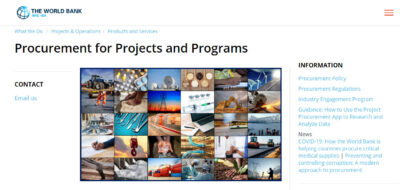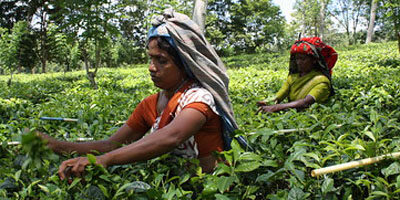Targeted, effective, accountable. These are the seemingly notable goals behind the dramatic reforms made in the last two years to the way Canada finances development assistance. The changes follow decades of calls from domestic and international think tanks to reform the old system, which gave a little slice of the pie to almost anyone who asked.
In the 1990s, Canada was operating in over 135 countries on a wide variety of issues, making it hard to gauge effectiveness or achieve large-scale results.
“All of the reforms are consistent with what the donor and NGO community have been telling CIDA for years – that it was too scattered and too top heavy,” says Stephen Baranyi, an associate professor at the University of Ottawa’s School of International Development and Global Studies. So why is that same donor and NGO community up in arms over the results?
The trouble is that not only was the community not consulted on the new program, the program itself has effectively been designed to shut out the community. The result is an ill-defined new aid scheme that enhances the power of the CIDA minister and PMO while reducing their accountability to the Canadian public. The changes have the potential to revolutionize the way Canada is seen by the world, but they’ve gone on largely out of the public eye.
“Occasionally moments come along in Canadian history that are defining to us as a nation,” said Liberal International Cooperation Critic Glen Pearson. “I think the way CIDA has been changed in the last two years is one of those moments.”
From Africa to partisanship
The Official Development Assistance (ODA) revolution was carried out in three steps, starting in February 2009 when CIDA announced that it would be concentrating 80% of Canada’s ODA into 20 countries. Eight African recipient countries were dropped, while a new focus was placed on Latin America, where the Conservative government has been trying to enhance its trade partnerships. It later announced that it was closing several African embassies.
Critics chastised the government for putting trade ahead of benevolence. “It was a major move away from Canada’s long-standing tradition of directing aid toward the poorest of the poor,” NDP International Cooperation and CIDA Critic John Rafferty said recently, reflecting on the change. Partners like Rwanda, which formerly had close ties to CIDA, can now only hope to qualify for the 20% of CIDA funds set aside for emergency relief.
CIDA has not disguised its adoption of a more partisan aid model.
“We chose those 20 countries based on their real needs, their capacity to benefit from aid, and their alignment with Canadian foreign policy priorities,” CIDA Minister Bev Oda said when announcing the new countries of focus. Later announcements would continue to stress compliance with Canadian foreign policy objectives as a key criterion in funding decisions.
But as a government-funded initiative, was the government wrong to try to advance its foreign policy through aid?
Pearson blames the system, not politics. “CIDA has always been part of the Department of Foreign Affairs and International Trade, so it has to be driven by foreign affairs,” he remarked. “It has to go to Afghanistan and it has to work with Canadian businesses on their trade objectives even when those objectives aren’t CIDA priorities.”
Indeed, CIDA existed for almost 30 years before being granted its first minister in 1995, and the current minister still reports to the Foreign Affairs Minister. Pearson says the only way CIDA will ever be able to act independently of Canadian foreign policy is if it is divorced from its parent ministry, making it an autonomous agency with its own cabinet minister and government mandate. A similar model is used in Britain.
The Canadian International Council (CIC), an international affairs think tank chaired by Research in Motion co-founder Jim Balsillie, recently released a report called “Open Canada” which charts a path for Canadian international affairs based on suggestions from academics, businesspeople and media figures. The report cites situations like post-communist Eastern Europe or post-apartheid South Africa as examples of when the government was justified in advancing its political interests through aid.
The report argues, however, that aid in such politically motivated situations shouldn’t come from the regular aid budget. Some aid can be partisan, it says, but it must be explicitly so.
Specific countries aside, CIDA might still be biting off more than it can chew by aiding 20 countries. The CIC said that even 20 are too many for Canada to be truly effective. Pearson countered that it is not the number of countries or the money spent but the efficacy of the program.
“CIDA was in 135 countries in 1995, then narrowed down to 50, then 35 and now 20. Yet it is less effective now. It was more effective with a budget of $2 billion than it is now with $5 billion.”
Holding the middle ground, development expert Baranyi said it made sense to concentrate in certain countries in order to track resources and get a better understanding of their needs, but it’s too early to say whether it’s more effective. “The results aren’t in yet,” he said, and without improved reporting measures, he worries those results may never be known. The solution, it seems, may lie deeper than numbers and figures.
Bringing focus, losing friends
The second change came with the September 2009 announcement of three new areas of program focus. CIDA would now limit 80% of NGO partner funding to those with projects that either increase food security, secure the future of children and youth, or stimulate sustainable economic growth. The announcement was short and development experts were left wondering exactly how they would be implemented.
Baranyi said it was particularly unclear where excluded themes, such as gender and development, would fit in the new scheme. “Minister Oda just said excluded themes would be cross-cutting priorities,” he said, providing an example of the oblique wording the ministry has come to favour. He suspects the themes will just lead to programming on the ground being relabeled – essentially partners adopting their own oblique language.
Many development projects cover multiple themes, noted Brian Tomlinson, Senior Policy Analyst at the Canadian Council for International Cooperation (CCIC) in a report critiquing the aid effectiveness measures. Would NGOs now be required to break up big projects into small focus areas and submit them individually for funding? CIDA’s guidelines provided no answer.
As any follower of CIDA policy will attest, the agency’s priorities shift frequently. If new projects have to be constantly created to meet new priorities, long-term, sustainable development is put at risk. “Groups get into three to five year funding streams then come out and find their projects are no longer within the government’s area of focus,” Pearson said, a frustrating situation that undermines their relationship with CIDA.
Development groups lose funding, CIDA loses their trust
The latest shift in priorities appears to provide CIDA an excuse to suspend ties with many long-time partners, most of whom argued their projects did in fact pertain to the focus areas. Partner NGOs grew increasingly insecure about their relationship with CIDA over the last two years as they experienced increasing delays in getting their projects approved. A senior CIDA staff member has traditionally had the authority to approve funding requests, but it became clear to anxiously waiting NGOs that their projects were now being routed through the minister’s office.
It isn’t uncommon for NGOs to remain in limbo for months or years waiting for a response on the status of their projects, often without bridge funds to tide them over. “These delays have a more pervasive impact than some of the funding cuts that have received more attention in the media,” said Tomlinson in an interview.
Long-standing partners were shocked when CIDA announced in November 2009 that it wouldn’t be renewing funding to KAIROS, an ecumenical development organization that, along with its predecessors, had worked with CIDA for 35 years. Documents made public from an Access to Information request show the project was approved at every level of the department, but when it reached the minister’s office, Minister Oda claimed the project didn’t fit within the three areas of focus, although KAIROS vehemently countered that it did. Several weeks later, Jason Kenney, Minister of Citizenship, Immigration and Multiculturalism, told audiences in Israel that KAIROS had been stripped of its funding because of its views on Israel, making observers suspect the government was trying to advance a partisan agenda not just through the countries it funds, but through its partner agencies as well. Montreal-based Alternatives and several other NGOs accused of having controversial viewpoints on the Middle East also lost funding. Whether the cuts came because their programs no longer fit within CIDA’s areas of focus, as it claimed, or because they no longer fit within Canada’s foreign policy, remains unclear.
The biggest blow to the NGO community came at the end of May 2010 when the Canadian Council for International Cooperation, a coalition that links and represents about 90 Canadian civil society organizations, also had its funding cut off. The cut marked the end of a 42-year relationship between CIDA, the Council, and by extension, the very core of the Canadian international development community, which the Council represents.
CIDA meanwhile loses access to an important source of information, expertise and feedback. “It makes no sense to shut civil society out when you have that kind of expertise at your fingertips,” said Rafferty.
Partners who were cut off from funding were left without much recourse. CIDA refused to elaborate on its decisions or meet with the NGOs. Affected organizations were forced to end programs and lay off staff. They can resubmit proposals, but it’s a long process with no signs of getting shorter.
Pearson says he has been working with between forty and fifty NGOs who have had their funding cut. They have given up, he says, not because they have lost hope but because they have lost trust in CIDA.
Unaccountable and piecemeal
The third and final piece of the aid reform came in July this year as CIDA introduced a new Partners for Development Program, a series of policies that it said would make its relationships with NGOs more effective. Scant details were offered but the announcement promised more streamlined and transparent processes in partnership decisions. CIDA also introduced a new Global Citizens Program (GCP), which aims to educate and involve Canadians, particularly youth, in development issues.
Development experts took issue with the announcement’s plans to focus on “the most meritorious proposals put forward by Canadian organizations.” In a critique of the announcement, Tomlinson said it sounded like a return to a competitive bidding environment, which can favour disruptive and unsustainable projects.
The most serious problem, however, is that the plan leaves little room for civil society funding, and without it, there is no one to hold the government accountable. Without funding, organizations like the CCIC won’t be able to observe, measure and evaluate the government’s performance on development.
Even before these changes, CIDA was not a particularly accountable agency. It has only reported regularly on two countries – Afghanistan and Haiti – and Baranyi says even that isn’t detailed enough, although weaknesses in host country governments are partly to blame. Otherwise, he says the general report that CIDA submits to parliament annually is insufficient. “The data is two to three years out of date and the language is convoluted.”
If NGOs have no way to access and evaluate government effectiveness, they won’t be able to critique it, which Rafferty believes is the government’s ultimate goal in making the funding cuts. “Groups are being told, ‘Heap praise on this government or lose your funding,'” he said.
He alludes to changes to the long-form census as another example of a major policy shift carried out without a scientific argument to support it, and whose ultimate goal is to limit access to information. “Both changes are a way of reducing the government’s accountability and cutting elected representatives, NGOs and citizens out of the debate,” he said. Ultimately, without funding to these organizations, the government is free to do as it likes, without citizens critiquing it or even being aware of it.
Baranyi sees the GCP as an attempt by CIDA to internalize the citizen engagement initiatives that were the former domain of NGOs like the CCIC. The program will still offer some opportunities for Canadians to participate in development, but without the critical edge present in independent organizations.
“The program is an attempt to institutionalize the marginalization of NGOs that do their own development education,” Baranyi said.
He is also critical of the government’s focus on youth in development strategy. “Sending 25-year-olds to Haiti is foolish and counterproductive and destructive,” he said, as similar programs have already shown.
CIDA used to have a well-developed public education infrastructure, Tomlinson said, but that was lost to restructuring in 1995. “Now CIDA just launches one-off engagement programs every few years,” he said.
There is no clear plan or programming behind the GCP, Rafferty added, calling it yet another plan announced by the government to appeal to certain segments of the population, “without any plan of how they are going to do it.”
Doing more with less?
CIDA had better hope its plans to be more effective are successful, because it’s going to have a lot less to work with in coming years. As part of the response to the financial crisis last year, the Canadian government froze aid spending for the foreseeable future. The freeze capped off ten years of laudable growth in the aid budget, bringing total spending to 0.3% of GDP. It’s a far cry from the famous 0.7% goal OECD countries set themselves, but at least it puts Canada near the average for donor countries.
The freeze could, however, quickly draw Canada to below that average. Pearson noted that many countries are now stepping up their aid efforts to prevent development from backsliding in recipient countries as result of the economic downturn.
Baranyi said that even attempts to make the aid we give more effective wouldn’t be enough. “With the exception of a few big recipient countries, such as Haiti and Afghanistan, we’re going to become too small a player, even in countries where we concentrate aid, to make a difference.”
Pearson noted that the 2010-2011 budget was more than a freeze – it was a broken promise. The government had previously committed to an 8% annual increase and, according to Pearson, partner countries had planned programming based on that figure. “Foreign ministers were stunned” at meetings in advance of the June G8 and G20 summits, Pearson said. “The government is calling it an aid freeze but it amounts to a $4.2 billion cut.”





